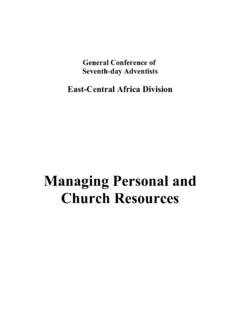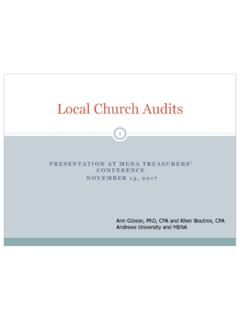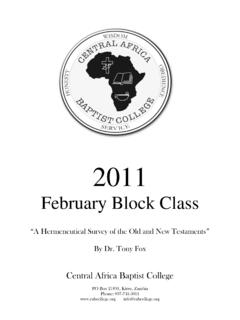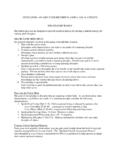Transcription of Seventh-day Adventist Church Organizational Structure
1 Seventh-day Adventist ChurchOrganizational StructureNe T easu e s O ie tatio e i a General Conference of SDA, North American DivisionMarch 28-29, 2016, Columbia, MarylandPresenter: Lowell C CooperMany parts. One movement!Legal Notice and Terms of UseCopyright 2016 by the General Conference of Seventh-day Adventists . All rights reserved. The information is provided for training purposes only and is not intended nor should it be used as legal counsel. This program may not be used or reformulated for any commercial purposes; neither shall it be published by any person or agency other than an official Organizational unit of the Seventh-day Adventist Church , unless prior written authorization is obtained from the General Conference of Seventh-day Adventists Office of Global Leadership Development. Subject to the foregoing terms, unlimited permission to copy or use this program is he e LJ g a ted upo i lusio of the opLJ ight oti e a o e.
2 E e th-daLJ Ad e tist a d Ad e tist a e registered trademarks of the General Conference of Seventh-day Adventists and may not be used by non- Seventh-day Adventist entities without prior written authorization from the General Conference of Seventh-day Adventists . Use of all or any part of this program constitutes acceptance by the User of these appreciate history of structural understand foundational principles for survey present global with a shepherd(Isa 40:11, Jn10:14-16) of Christ(Rom 12:5, 1 Cor 12:27, Eph 1:23) and branches(Jn15:5) of faith(Eph 2:19, 1 Tim 3:15) of God(Deut 14:2, Rom 8:15, Gal 4:5-6) of God(Matt 5:9, Rom 9:26, 1Jn 3:1-10) (Mt 16:18, 1 Cor 3:10, Eph 2:21, 1 Pet 2:5) (Isa 62:5, 2 Cor 11:2, Rev 19:7) A particular group of believers in a town or larger family of faith, of which the local Church is a of many Christian universal family of reality divine and humanInvisible and visible boundariesIncorporated and unincorporatedParticipation is voluntary and yet obligatoryGlobal and local identitiesNot-for-profit but Church pioneers had an anti-organization bias arising in part from their personal experience of being disfellowshipped from their denominations before and after ga izatio as e uated ith Ba LJlo considerations prompted need for of of of is necessary to fulfill mission The details of organization may vary according to conditions and work,but ever as God has called his Church together there has appeared in it the spiritual gift of order and of government, the spirit that rules in heaven.
3 W. A. Spicer, "The Divine Principle of Organization," Review and Herald, 25 March 1909, is necessary to fulfill contains principles not prescriptionsBoth James White and Joseph Bates initially claimed that Organizational design should be patte ed afte the pe fe t sLJste of o de , set fo th i the Ne Testa e t. ( H, Ja , 1855, 164).Ho e e , LJ White a gued that e should not be afraid of that system which is not opposed by the Bible, and is approved by sound sense. ( H, JulLJ , , e phasis supplied). Ideas concerning organization and Structure had shifted from biblical literalism to biblical principle and common sensei the light of the hu h s needs and is necessary to fulfill contains principles not design informed by missionIn Adventism, mission ( evangelism ), and Church organization are not separate issues but are united, with organization providing the delivery system for effective mission.
4 The main theological pillar undergirding Adventist Church Structure is eschatology. Mission is an outgrowth of eschatology since Adventism believes that the message of the three angels must be preached to all the world before the end of Knight, Organizing for Mission, is necessary to fulfill contains principles not design informed by centralization/decentralizationThe purpose of centralization was more for coordinationthan for purpose of decentralization was more for responsiveness to local situationsthan for part of the Church can exist on its own, nor can any part act as if it exists only for is necessary to fulfill contains principles not design informed by unity/permit diversity If e ill get this thi g deep i ou e will not bind ourselves about with red tape and feel that everything must go in just the same way. There are different fields sometimes that demand different organizations, and I hope that when that field comes, and when that time comes, and that place comes, that God will have men that will be willing to break the red tape, if necessary, and form the organization in harmony with the field, and according to the de a ds of the o asio.
5 M C Wilcox (Sten 1903, April 9, a903, 20, 20a, cited in Barry Oliver, SDA Organizational Structure , p. 302) We see many things differently from what we did ten years ago, and I expect that we shall see still more. As new light comes, we ought to advance with it, and not hold rigidly to old forms and old methods. Because a thing is done a certain way in one place is not reason why it should be done in the same way in another place, or even in the same place at the same time. European Conference Bulletin, 2, quote from A G Daniells in 1902 Local churchLocal conference/missionUnion conference/mission/of churchesGeneral Conference and its divisionsThe General Conference represents the collective and worldwide expression of the Seventh-day Adventist Church . Church organizations around the world recognize the General Conference in Session as the voice of the Church . The General Conference Session, and the General Conference Executive Committee between Sessions, is the highest ecclesiastical authority in the administration of the Church .
6 Lo al hu hes, lo al o fe e es/ issio s/fields, union conferences/missions, unions of churches, and institutions are, by vote of the appropriate constituency, and by actions of properly authorized executive committees, a part of the worldwide organization of the Seventh-day Adventist each has accepted the privilege and responsibility of representing the Church in its part of the world, each is therefore required to operate and minister in harmony with the teachings and policies of the Church , and the actions of the world Church in individual units of the Church are given freedom to function in ways appropriate to their role and culture, no part of the worldwide organization of the Church has a unilateral right to se ede. GC Working Policy B 10 basis of and authority system under administration, not of entities (mission, purpose, belief create bond of fellowship) sharing (tithes, offerings, personnel) but not independent organizationsSDA Church Structure is often described as being very hierarchical with multiple levels of organization exercising various degrees of control over subsidiary units.
7 This is an unfair caricature of denominational organization. From an operational standpoint the various levels of Church Structure fulfil collaborative and supervisory functions entrusted to them by their member it is often necessary, for descriptive purposes, to speak of different levels of Church Structure , such terms must be viewed in the context of collaboration and cooperationNo matter who you are, where you live or what title you hold you are part of something much bigger. Your post of leadership, important as it may be, must stay connected/aligned/in sync with the rest of denominational Structure . In order to function at all every organization requires a system of authority. The dominant models for Organizational authority may be seen in government (spectrum of autocratic to democratic); business (sole proprietor to share holder, CEO); and military (top down authority).The Church is different from other organizations (government, army, business) in many respects.
8 It has as different system of authority, a different purpose for existence. It is a voluntary organization and functions on a not-for-profit basis. The Church has always had to wrestle with its self-perception as an institution or a to define, protect, and preserve their always dynamic and run the risk of dissipation and loss of its NT beginnings and for varied reasons the institutional Church gradually exercised increasing control of ecclesiastical functions and underscores the importance of Organizational uneasy coexistence of the institutionalized Church and private initiative French merchantWanted to restore NT teachingsTranslated scripture into vernacularEncouraged Bible study and memorizationWas branded as a hereticFollowers persecuted, scattered, and destroyedNative of EnglandTranslated Bible into language of massesTaught that laity could participate in ministryBranded as a heretic, enemy of ChurchDied a natural deathCouncil of Constance 40 years later.
9 Bones exhumed and publicly burnedGenerally portrayed as theological revolt against papal distortion of forgivenessHeart of the reformation was the conviction that all believers were priestsEvery believer has right and responsibility to study Bible, to be involved in ministry, administer sacraments When my Church preaches about the ministry of the laity, it speaks in broad and idealistic terms, but when it comes to reality, my Church sees lay ministry purely in terms of service to the institutional teaching, leading worship, visiting members, serving on committees, and giving time and money to the o ga izatio . William Diehl MLJ hu h ed pe ts f o e that I ill o e to the Church services with the holy book, the hymn book and the pocket book; and to be quiet and o plia t. A laymemberCongregationalHierarchicalInter locking and interdependent"Because leadership is necessarily an exercise of authority, it easily shifts into an exercise of power.
10 But the minute it does that, it begins to inflict damage on both the leader and the led." Eugene Peterson, The Message, Introduction to 2 Corinthians There is no question but that there should be authority in the Church but who should have it? And how does authority operate in a faith-based community that considers Jesus as its head? In the ea lLJ s General Conference PresdientGeorge Butler authored a pamphlet entitled Leadership (1873) built upon the premise of autho itLJ e t alized i o e pe so He presented it at camp meetings and preaching appointments to rave reviews by hearers who were acculturedto the G eat Ma odel of governance. The essence of this tract o u i ated that o e pe so as i ha ge and other leaders were subordinate to that pe so . All e e to a uies e to the de isio of one 1873 General Conference Session affirmed by majority vote that the position proposed by Butler reflectred the view of the General Conference on did not argue that he, the GC President, should have this authority.










